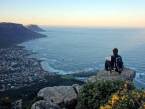TABLE MOUNTAIN NATIONAL PARK
Table Mountain, Cape Point, Lion’s Head and Signal Hill.
All these landmarks lay inside the mountainous Table Mountain National Park which stretches from Cape Town city along the peninsula to the tip of Cape Point. The park’s vegetation – fynbos – contains the most diverse botanical biosphere in the world and consists of many rare and endemic species.
The rugged chain of mountains, forests and beaches can be accessed on foot (Signal Hill and Lion’s Head), cable car (Table Mountain) and by car travelling to the various sections that make up this national park, such as Boulders Penguin Colony or Cape Point. Hikes range from walking up Lion’s Head on a full moon night to the strenuous Hoerikwagga multi-day hike.
Conservation fees differ for the various access points and accommodation (mainly at the Cape Point section) ranges from historical cottages to tented camps. Staying the night is the most practical option when you want to hike in this area. Most visitors overnight in Cape Town and visit the park on day trips. Gate opening times vary, but Cape Point can be accessed from 06:00 from October to March.
Getting there:
Self-drive from Cape Town or join a day excursion to Cape Point and around the peninsula. A guided slack-pack hike on Table Mountain can be arranged.
Best for:
Hiking, secluded beaches, penguins (Boulders beach), seeing fynbos and stunning landscapes – both mountain and ocean.
Ideal visit:
Day trip or self-drive.
Activities:
Hiking, swimming, horse-riding (Noordhoek beach), diving, fishing, mountain biking, forest walks and surfing.
Tips:
You don’t have a car? Take the Blue Mini Peninsula Tour on the red City Sightseeing busses in Cape Town.
Visit Table Mountain in the morning; from December to February strong winds may blow in the afternoon.
Allow at least half a day to visit the Cape Point section. If you have a car, take one of the scenic routes in the park.



















